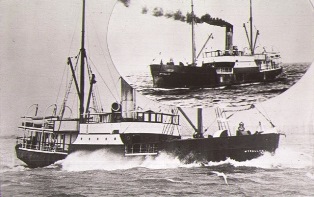
S.S. Wyrallah
The ‘Wyrallah’ was on its usual run from Melbourne to the Gippsland Lakes with a general cargo, including timber, benzene and confectionery under the command of first time Captain, Richard Bracken, when, at 10.20 pm on 8 April 1924, the ship collided with the inward bound steamship ‘SS Dilkera’ just inside Port Phillip Heads. Aboard the ‘Wyrallah’ were two passengers and a crew of thirteen. The ‘Wyrallah’ was nearly cut in half by the ‘Dilkera’, which had been travelling at full speed when it first sighted the ‘Wyrallah’. ‘Wyrallah’ sank within 10 minutes.
‘Wyrallah’ was an iron, screw driven, steam ship, 140 ft long, 206 nett tons, originally built by Mort’s Dock and Engineering Co, Balmain, Sydney in 1887 for the northern rivers of NSW. The ship had been chartered by Gippsland Steamers from Huddart Parker Ltd. ‘Wyrallah's’ master was blamed by the Court of Marine Inquiry for the wreck as his vessel was on the wrong side of the Shipping Channel. The vessel’s location was later located by divers in 23 metres of water and the site declared a protected wreck by Heritage Victoria. Robert G. Menzies, later Prime Minister of Australia, and whose sons attended Geelong College, acted for the Crown Law Department in relation to the wreck.